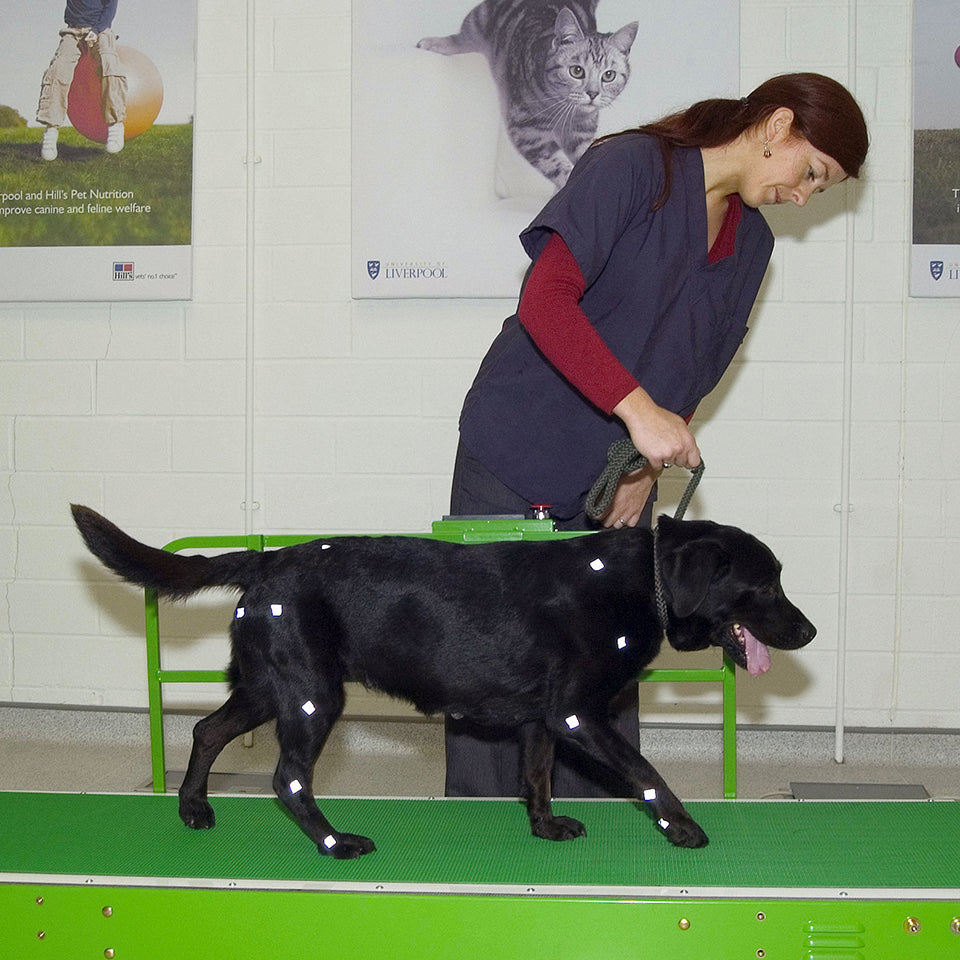What many pet owners consider a general slowing-down and aging in pets may actually indicate the animal is in pain, specifically chronic joint pain. If your dog experiences difficulty getting up, jumping, or seems stiff, canine arthritis may be the reason behind it all. So what is canine arthritis and can it be cured?
What is Canine Arthritis?
/arthr =Joint
/itis =Inflammation
It is the most common chronic condition of the joints, affecting about 1 in 5 adult dogs and 4 in 5 geriatric dogs (over the age of 8 years old)
Arthritis is a degenerative joint disease that affects the entire joint organ, causing cartilage tissue that protects the bones and joints to deteriorate gradually and irreversibly. The joint will then lose its cushion causing friction between bones. As a result, the inner lining of the its capsule becomes inflamed, and the outer fibrous layer becomes thickened. Although any joint in a dogs’ body can be affected by this condition, the most commonly affected ones are the hips, elbows, lower back, knees and wrists.
Furthermore, inflammation of the cartilage due to increased friction stimulates bony growths (bone spurs/osteophytes) to form along bone edges around the joint resulting in bone remodeling, thus losing its ability to absorb concussional forces, making it stiffer and more difficult to move.
What Causes Arthritis?
Just like humans, dogs generally develop arthritis as they get older due to general wear and tear on the joints. However, most cases arise in dogs with an inherited orthopedic disease such as hip and elbow dysplasia, or those who have suffered from old injuries or repeated trauma to joints. Certain breeds are also more at risk, including Labradors, German shepherds and Rottweilers.
In addition to that, obesity and metabolic diseases such as diabetes also lead to arthritis later in life.
What Are the Symptoms of Arthritis?
Since arthritis is a progressive disease, symptoms develop and worsen over time. Dogs can display a variety of signs, the most common of which are:
- Continuous licking of a specific joint (Signs of saliva staining)
- Limping or stiffness, especially in the morning or after long periods of rest
- Muscle atrophy
- Reluctance to walk, jump and play normally
- Swollen or sore joints
- Unusual aggression towards other dogs and/or humans.
- Whimpering or trembling
- Worsening signs when cold or damp

Can Arthritis Be Cured?
Unfortunately, arthritis can’t be cured. But why is that?
- Once cartilage tissue has been damaged, it rarely repairs itself completely
This is why it’s crucially important to manage this condition to control further deterioration and damage, and to minimize the pain and discomfort it causes to our dogs for them to live a good quality life.
- Non-medical approaches to minimize arthritic aches and pains include:
- Weight control:
Arthritis is commonly worse in overweight dogs due to added strain placed on the joints and vertebrae causing severe and irreversible damage. It is essential for the dog to be in a lean body condition to avoid adding extra stress on the joints.
- Exercise/ Animal physical rehabilitation:
Light to moderate exercise is important to strengthen the muscles while keeping stiff joints mobile and supple. The ideal activity for affected dogs is swimming: putting no pressure on the joints and ligaments, the increased movement and the mobility achieved underwater is ideal to minimize stiffness.
- Nutraceuticals:
Those are feed supplements designed to strengthen and support the healthy function of dogs. In this case, joint supplements rich in glucosamine, chondroitin sulfate and omega fatty acids are used since they can assist in the natural repair and regeneration of cartilage. And due to their anti-inflammatory and analgesic properties, they ease arthritis symptoms in dogs.
- Acupuncture therapy:
Acupuncture therapy is well known for alleviating pain and improving joint range of motion especially for dogs suffering from hip dysplasia and degenerative joint disease. Therefore, it has been used as a complementary treatment for dogs with arthritis.
Medical approaches to minimize arthritic aches and pains include:
- Non-steroidal anti-inflammatory drugs: NSAIDs:
NSAIDs are suitable for patients with arthritis because of their analgesic and anti-inflammatory properties. Unfortunately, long term use of these drugs may cause liver and kidney damage as a side effect, therefore it is advisable to run a blood test prior to starting these medications.
- Glucocorticoids:
Commonly known as steroids or cortisone, these drugs have a higher anti-inflammatory effect than NSAIDs, but long-term use may cause more obvious and serious side effects.
Note that NSAIDs and glucocorticoids CANNOT be used together.
- Chondroprotective drugs:
Unlike anti-inflammatory drugs which tend to treat symptoms of arthritis, chondroprotective injections target the progression of the disease by reducing cartilage degeneration caused by destructive enzymes, as well as stimulating joint capsule cells to produce lubricating joint fluid, promoting repair of joint structures and reducing swelling by blocking inflammatory processes.
Surgical management of arthritis:
If your dog’s joints become severely damaged or if the pain is intense even with use of medical therapy, surgical treatment of arthritis should be considered.
Surgical treatment can be divided into three main types, depending on the joint or joints affected.
- Total joint replacement
- Joint fusion: Arthrodesis
- Surgical removal of part of a joint: Excision arthroplasty
1- Total Joint Replacement:
Currently, in veterinary orthopedics, total joint replacement is the primary surgical option for treating arthritis of the coxofemoral joint* in dogs suffering from hip dysplasia, knowing that arthritis will eventually develop in dogs born with this condition.
Coxofemoral* joint: Hip joint, where the femur articulates with the concave surface of the pelvis, the acetabulum. Commonly known as a ball-and-socket joint.
NB: Hip dysplasia is a hereditary disorder that occurs during the growing stage of dogs of larger breeds. It results in the loosening of the hip joint, which leads to dysfunction and pain. As the dog grows, the cartilage and bone of the hip begin to wear down. This eventually results in arthritis, muscular atrophy, and decreased mobility.
Hip replacement surgery (THR) involves the replacement of the arthritic hip joint with a new artificial “ball-and-socket” implant. Since the 1970s, THR has developed into a common and highly successful treatment for canine coxofemoral arthritis, due to the inherent stability provided by the spheroid (ball-and-socket) joint implant as well as its surgical accessibility. When considering THR, an appropriate candidate would be skeletally mature (over 10 months of age), free from concurrent infection and/or coexisting orthopedic abnormalities. Therefore, a physical examination is essential prior to performing this surgery.
In more recent years, prostheses for hips, elbows, stifles, hocks and shoulders have also become available but it remains challenging to achieve good outcomes due to the complexity of these joints.
2- Joint Fusion: Arthrodesis:
Arthrodesis was developed as one of the early surgical treatments of arthritis and remains one of the mainstays of treatment in veterinary orthopedics, commonly used in lower motion joints such as the carpus (wrist) and tarsus (hock) joints. It is performed only when joint injury leading to severe pain and dysfunction can’t be palliated by other surgical or medical methods.
Arthrodesis is the fusion of two or more bones in a joint. It consists of removing of the cartilage within the affected joint, cutting off bone ends and using metal implants (often a metal plate and screws) to hold the joint permanently in a normal standing position. This leads to no further motion in the joint, so pain caused by instability is eliminated.
3- Excision arthroplasty:
Excision arthroplasty is a procedure mainly performed in the coxofemoral (hip) joint. It involves the removal of the affected articulation and allows function through the formation of a fibrous tissue within the gap, also known as a false joint or pseudoarthrosis. Nevertheless, pain relief with adequate function can be achieved preferably in smaller dogs rather than big dogs.
In conclusion, arthritis is a very common degenerative disorder in our canine companions, which leads to pain, discomfort and loss of mobility. Sadly, at the moment, it’s a condition that’s tough to treat. That said, maintaining a lean body condition throughout growth and into adulthood is the most important way to prevent arthritis from developing. Non-medical and medical approaches are always available to reduce its symptoms, but surgery remains the only solution to treat it. Ideally, the goals of surgery should always be complete pain relief and return to full function. However, this can only be accomplished in certain cases of arthritis.


